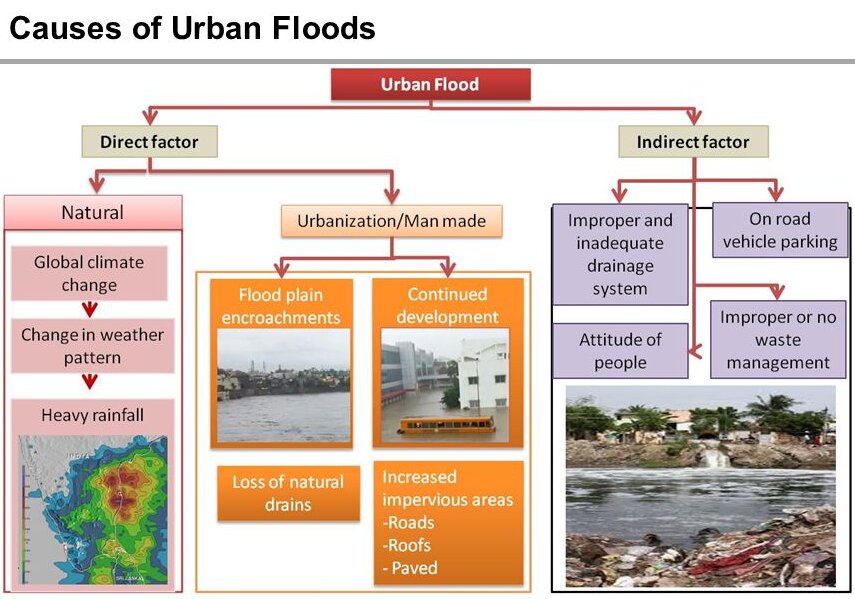Biodiversity & Environment
Urban Flooding
- 31 Oct 2020
- 7 min read
This article is based on “Time for a ‘sponge cities’ mission in India” which was published in The Hindu on 31/10/2020. It talks about how urban flooding is man-made disaster and ways to deal with it.
Recently, torrential rains that took place in Hyderabad have caused massive urban floods. In many Indian cities, the urban floods have become a frequent phenomenon in recent years.
As the incidence of climate variability and extreme weather events increases, urban flooding becomes more and more common. While the untimely heavy rains can be attributed to climate variability, the urban flooding is largely due to an unplanned urbanisation.
Urban Flood: Man-Made Disaster
Overburdened drainage, unregulated construction, no regard to the natural topography and hydro-geomorphology all make urban floods a man-made disaster.
- Inadequate Drainage Infrastructure: Cities like Hyderabad, Mumbai rely on a century-old drainage system, covering only a small part of the core city.
- In the last 20 years, the Indian cities have grown manifold with its original built-up area.
- As the city grew beyond its original limits, not much was done to address the absence of adequate drainage systems.
- Terrain Alteration: Lasting irreversible damage has been done to the city by property builders, property owners, and public agencies by flattening terrain and altering natural drainage routes.
- Reducing Seepage: Indian cities are becoming increasingly impervious to water, not just because of increasing built up but also because of the nature of materials used (hard, non-porous construction material that makes the soil impervious).
- Lax Implementation: Even with provisions of rainwater harvesting, sustainable urban drainage systems, etc, in regulatory mechanisms like the Environmental Impact Assessment (EIA), adoption at user end as well as enforcement agencies remains weak.
- Encroaching Natural Spaces: The number of wetlands has reduced to 123 in 2018 from 644 in 1956.
- Green cover is only 9 per cent, which ideally should have been at least 33 per cent.
Way Forward
- Need For Holistic Engagement: Urban floods of this scale cannot be contained by the municipal authorities alone. Floods cannot be managed without concerted and focused investments of energy and resources.
- The Metropolitan Development Authorities, National Disaster Management Authority, State revenue and irrigation departments along with municipal corporations should be involved in such work together.
- Such investments can only be done in a mission mode organisation with active participation of civil society organisations at the metropolitan scale.
- Developing Sponge Cities: The idea of a sponge city is to make cities more permeable so as to hold and use the water which falls upon it.
- Sponge cities absorb the rain water, which is then naturally filtered by the soil and allowed to reach urban aquifers.
- This allows for the extraction of water from the ground through urban or peri-urban wells.
- This water can be treated easily and used for city water supply.
- Wetland Policy: There is a need to start paying attention to the management of wetlands by involving local communities.
- Without doubt, terrain alteration needs to be strictly regulated and a ban on any further alteration of terrain needs to be introduced.
- To improve the city’s capacity to absorb water, new porous materials and technologies must be encouraged or mandated across scales.
- Examples of these technologies are bioswales and retention systems, permeable material for roads and pavement, drainage systems which allow storm water to trickle into the ground, green roofs and harvesting systems in buildings.
Note:
- Bioswales are made along roadsides so that rainwater from the road flows towards them and percolates into the ground.
- Drainage Planning: Watershed management and emergency drainage plan should be clearly enunciated in policy and law.
- Urban watersheds are micro ecological drainage systems, shaped by contours of terrain.
- Detailed documentation of these must be held by agencies which are not bound by municipal jurisdictions; instead, there is a need to consider natural boundaries such as watersheds instead of governance boundaries like electoral wards for shaping a drainage plan.
- Water Sensitive Urban Design: These methods take into consideration the topography, types of surfaces (permeable or impervious), natural drainage and leave very less impact on the environment.
- Vulnerability analyses and risk assessments should form part and parcel of city master plans.
- In a changing climate, the drainage infrastructure (especially storm water drainage) has to be built considering the new ‘normals’.
- Tools such as predictive precipitation modelling can help do that and are also able to link it with the adaptive capacity of urban land use.
- Convergent Approach: These can all be delivered effectively through an urban mission along the lines of the Atal Mission for Rejuvenation and Urban Transformation (AMRUT), National Heritage City Development and Augmentation Yojana (HRIDAY) and Smart Cities Mission.
Conclusion
Urban Flood management will not just help control recurring floods but also respond to other fault lines, provide for water security, more green spaces, and will make the city resilient and sustainable.
|
Drishti Mains Question While the untimely heavy rains can be attributed to climate change, the urban flooding is largely due to an unplanned urbanisation. Discuss. |
This editorial is based on “The Politics of a $5 Trillion Economy” which was published in The Economic Times on October 29th, 2020. Now watch this on our Youtube channel.





